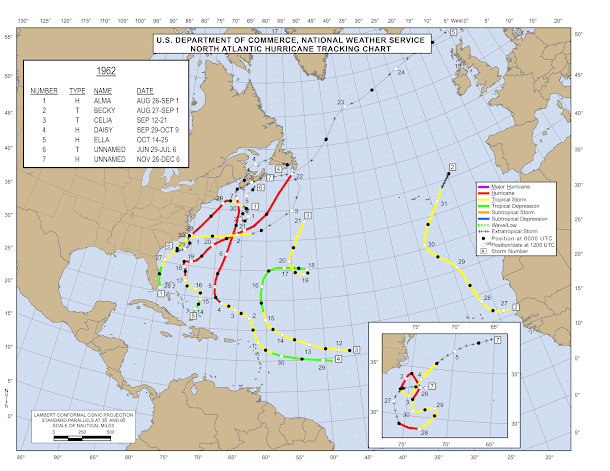Can the ENSO data be
used to determine/forecast the Atlantic hurricane season intensity? The answer is yes and no. There are many factors leading up to an
active hurricane season, and the ENSO analysis helps determine the strength of
the sea surface temperature anomalies during the season.
Comparing the 2005,
2020, 2021 and 2024 Atlantic Hurricane Seasons helped paint a better picture as
to how different these ENSO analyses were.
To recap, an El Nino seasonal pattern means the Atlantic is experiencing
warmer than average ocean temperature anomalies in the measured regions. These are measured in 3 month increments. The La Nina indicates below average sea
surface temperature anomalies in the measured zones. Not every historic hurricane season in the Atlantic
is associated with a warmer than average SST.
There is actually more proof that the hurricane season is more active during
a neutral ENSO phase or transition to El Nino or La Nina. Not one is favored to have a more severe
hurricane season than the other. The only
data set that shows more intense/active hurricanes in the Atlantic is the neutral
phase. Which proves that during NORMAL SSTs,
the Atlantic hurricane season is more active.
In 2005, the Atlantic Hurricane season reached a historic
record with tropical systems running into January 2006. The winter season of 2005 started off with a
low end El Nino, transitioned to a neutral phase into spring and summer, then a
low end La Nina by the end of the year/beginning of 2006. The 2005 Atlantic hurricane season had a total
of 28 named storms, including 2 major hurricanes in July, 1 major in August, 2
in September and 2 in October. This
season included Katrina, Dennis, Maria, Wilma (record breaking pressure
readings), Rita, and the infamous Greek alphabet names due to reaching the
limit on the English alphabet names.
In 2020, there was a record breaking 30 named Atlantic
Hurricanes, including a major in August, September, and 4 majors in October,
already using the Greek alphabet by then.
This season included Laura, Teddy, Delta, Epsilon, Zeta, Eta and Iota. This season kicked off early in May and ran
until almost Thanksgiving with the last tropical systems being named a week before. The climatological analysis of 2020 starts
the year off in neutral phase, transitions to weak La Nina in late summer, and
then began the 3 year long La Nina streak.
In 2021, there were 21 named Atlantic Hurricanes, including
2 major hurricanes in August (Grace and Ida), Larry the major hurricane going
into September, as well as Sam. The
season again started with tropical development in May and ended in the first week of November.
The 2020 ENSO is mentioned above, and the rest of 2021 was in La
Nina. This is COOLER than average
SSTs. This hurricane season was toned
down a bit compared to 2005 and 2020 however 21 named storms is still a high
number.
For 2024 season so far, we have had 13 named Atlantic
storms, including 1 major in June, 3 hurricanes in August/Sept, 2 major
hurricanes in Sept, and 1 major hurricane in October. Now the Atlantic Hurricane season isn’t over
until November 30th, but as history shows us, this does not mean the
tropics will no longer be active. For
this year’s ENSO analysis, we were finishing out 2023 from the long La Nina
period, transitioned into neutral in winter/spring of 2023, then began El Nino
in the summer, and now currently in a neutral phase with La Nina projected to
begin this winter.
According to this data, there is no direct correlation between
an El Nino/La Nina season and the strength/activity of the Atlantic Hurricane
Season. Yes, the ocean temperatures are
warming, however above average SST anomaly seasons do not always result in a
more active Atlantic Hurricane season. I
have found evidence that during a neutral ENSO phase is when the Atlantic
Hurricane season is more active. This
also is not conclusive, not every neutral phase results in a more active season
either. Again, the wind shear, ACE, and
PNO also have a factor in the intensity/activity of the Atlantic Hurricane
Season.
Thanks for reading!








